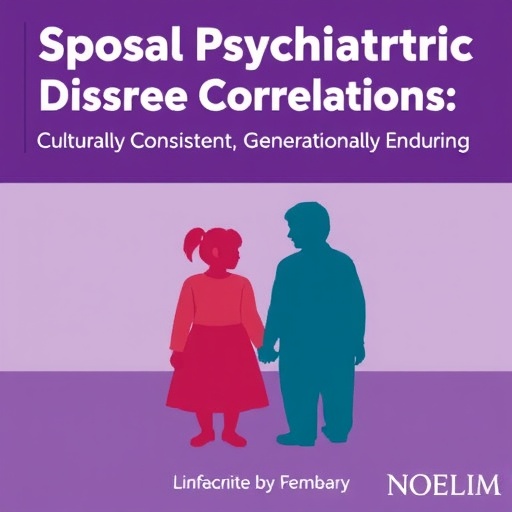Recent research has opened new avenues of understanding complex human behaviors, particularly in the context of psychiatric disorders and marital dynamics. The patterns that emerge from spousal correlations in these disorders reveal much about the underlying genetic, environmental, and social frameworks influencing mental health. In a groundbreaking study conducted across three national registries, the robustness of these correlations has been analyzed, shedding light on the significant implications for both public health and psychiatry.
As the study draws from a staggering dataset encompassing millions of spousal pairs, it highlights how partner similarities in psychiatric traits play a pivotal role in shaping the prevalence of various disorders. The researchers meticulously examined nine distinct psychiatric disorders, seeking to unravel the intricacies of how these traits manifest among spouses. Understanding these correlations is crucial, as they not only enrich our comprehension of psychiatric conditions’ dynamics but also provide a more nuanced perspective on familial and hereditary factors contributing to mental health.
Delving into the historical context, the study offers a comparative analysis between Taiwan, Denmark, and Sweden—three culturally distinct nations yet interconnected through the shared experience of mental health challenges. The findings revealed a surprising degree of consistency in spousal correlations across these regions, even as they adapted to their unique societal frameworks. This consistency raises critical questions about the universal nature of psychiatric disorders, suggesting that while cultural contexts may shape the experience of mental health, the underlying mechanisms may be inherently similar across diverse backgrounds.
Focus on Taiwan’s generational trends yields fascinating insights. Investigators discovered that spousal correlations for individuals born post-1930 exhibited notable changes, which could reflect a shift in societal norms, values, and environmental factors impacting mental health. This generational lens not only enriches the findings but also encourages critical conversations around how evolving societal structures influence psychiatric traits among married couples over time.
The study’s implications extend far beyond academic curiosity; they raise vital considerations for mental health practitioners, policymakers, and researchers. Understanding that spousal correlations exist for a variety of psychiatric disorders provides a valuable framework for addressing comorbidity rates. As many mental health disorders do not exist in isolation—as reflected in their spousal manifestations—the findings suggest that therapeutic interventions could benefit from a couple-focused approach, addressing both partners’ mental health needs to foster more effective treatment outcomes.
Moreover, the research highlights the pressing need for large-scale studies examining the cultural aspects of spousal correlations. Despite the study’s significant contributions, there remains a shortage of comprehensive analyses that dissect variations across different cultural landscapes. Recognizing that cultural contexts play a role in shaping the manifestation of psychiatric traits can inform targeted approaches that consider the socio-cultural dynamics at play, enabling more effective policies and beneficial interventions tailored for specific populations.
In addition to cultural factors, the genetic architecture underlying these correlations warrants further exploration. The study opens up avenues to interrogate how polygenic influences may converge within couples, leading to observable patterns in mental health. Such investigations can unravel the complex interplay between genetics and environment, contributing to a broader understanding of how psychiatric disorders manifest within interpersonal relationships.
The importance of these findings also extends into the realm of public health. By acknowledging the spousal correlations for psychiatric disorders, health agencies can devise more informed strategies for mitigating the impact of these conditions on families and communities. This proactive stance could lead to more effective screening programs and early interventions that address potential mental health risks stemming from familial interactions.
As society continues to evolve, the significance of understanding psychiatric disorders—and how they correlate among spouses—will remain paramount. This study underscores the necessity for an integrative approach in mental health research, encompassing genetic, cultural, and social dimensions. Ultimately, grasping these correlations will not only enhance our understanding of psychiatric disorders but also fortify our collective efforts to promote mental well-being.
In essence, the investigations reveal that spousal similarities in psychiatric disorders extend across cultures and generations, offering a compelling insight into the dynamics of mental health inheritance and interaction. As researchers, practitioners, and policymakers navigate this complex terrain, these foundational insights will pave the way for innovative and compassionate approaches to mental health care.
Investigating the nuances of psychiatric disorders through the lens of marital relationships illuminates a pathway toward holistic understanding and treatment. Stakeholders at all levels must take heed of these findings to create support systems that acknowledge the interconnectedness of mental health within intimate relationships. Only through such comprehensive frameworks can we hope to address the multifaceted nature of mental health disorders in our ever-evolving world.
In summary, the exploration of spousal correlations in psychiatric disorders stands as a testament to the rich interplay between mental health, relationships, and cultural context. As we strive to navigate this intricately woven landscape, continued research in this area is vital for illuminating the connections that lie beneath the surface of human experiences. The future of mental health research is undoubtedly intertwined with the familial and relational dynamics that shape our understanding of these conditions.
Subject of Research: Spousal correlations in psychiatric disorders
Article Title: Spousal correlations for nine psychiatric disorders are consistent across cultures and persistent over generations.
Article References:
Fan, C.C., Dehkordi, S.R., Border, R. et al. Spousal correlations for nine psychiatric disorders are consistent across cultures and persistent over generations.
Nat Hum Behav (2025). https://doi.org/10.1038/s41562-025-02298-z
Image Credits: AI Generated
DOI: 10.1038/s41562-025-02298-z
Keywords: psychiatric disorders, spousal correlation, culture, generation trends, mental health dynamics, familial relationships, public health implications, genetic architecture, comorbidity.




